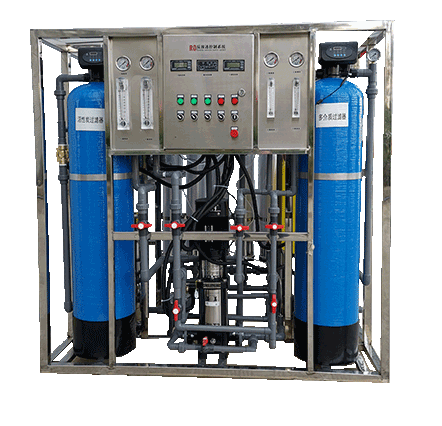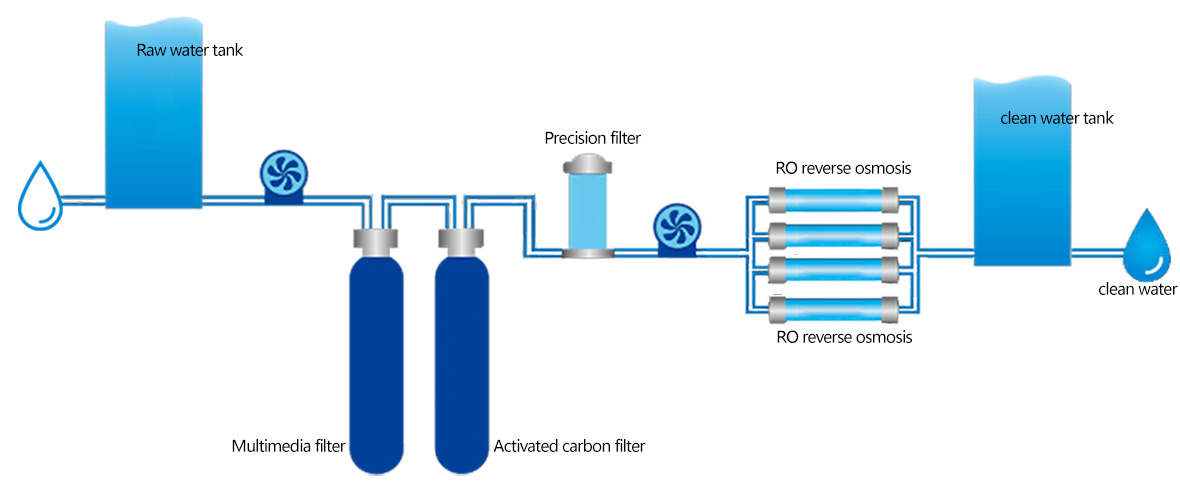In today's industrial landscape, access to clean and pure water is crucial for a wide range of applications. From manufacturing processes to drinking water supply, the need for effective water purification technologies has never been more critical. One such technology that has gained widespread adoption is Reverse Osmosis (RO). This article delves into the intricacies of RO, exploring its product features, working principles, technical specifications, and diverse application areas.
Reverse Osmosis (RO) is a water purification technology that uses a semi-permeable membrane to remove ions, molecules, and larger particles from water. It is widely regarded as one of the most effective methods for producing high-quality, purified water. RO systems are available in various configurations, ranging from small residential units to large industrial systems capable of processing thousands of gallons per day.

Key Features of RO Systems:
High Efficiency: RO systems are known for their high efficiency in removing contaminants, including dissolved salts, bacteria, viruses, and organic compounds.
Versatility: Suitable for a wide range of applications, from residential water purification to large-scale industrial processes.
Low Energy Consumption: Modern RO systems are designed to be energy-efficient, reducing operational costs.
Compact Design: RO units are available in compact designs, making them easy to install and maintain.
Scalability: RO systems can be scaled up or down to meet specific water purification needs.
The working principle of Reverse Osmosis revolves around the concept of osmosis, a natural process where water moves from a region of low solute concentration to a region of high solute concentration through a semi-permeable membrane. In RO, this process is reversed by applying external pressure to the concentrated side of the membrane, forcing water molecules to move to the less concentrated side, leaving impurities behind.
Components of an RO System:
Pre-filtration: The water first passes through pre-filters to remove larger particles, sediments, and chlorine, which can damage the RO membrane.
High-Pressure Pump: A high-pressure pump is used to increase the pressure of the water, enabling it to pass through the semi-permeable membrane.
RO Membrane: The heart of the system, the RO membrane, allows only water molecules to pass through while rejecting contaminants.
Post-filtration: After passing through the RO membrane, the purified water may go through additional post-filters to remove any remaining impurities and enhance taste.
Storage Tank: The purified water is stored in a tank, ready for use.
Flow Restrictor: A flow restrictor is used to regulate the flow rate and maintain the necessary pressure for the RO process.
Drain Line: The rejected contaminants are flushed away through a drain line.
The performance of an RO system is determined by several technical parameters, which vary depending on the specific application and system design. Here are some of the key technical specifications to consider:
Recovery Rate: The percentage of the feed water that is converted into purified water. Typical recovery rates range from 50% to 85%, depending on the system design and feed water quality.
Rejection Rate: The percentage of contaminants removed by the RO membrane. High-quality RO membranes can achieve rejection rates of 95% to 99%.
Operating Pressure: The pressure required to push water through the RO membrane. This typically ranges from 150 to 800 psi, depending on the feed water quality and system design.
Flow Rate: The volume of purified water produced by the system, usually measured in gallons per day (GPD) or liters per hour (LPH). Industrial RO systems can produce anywhere from a few hundred to several thousand GPD.
Membrane Type: RO membranes are available in various materials, including thin-film composite (TFC), cellulose acetate (CA), and polyamide (PA). TFC membranes are the most commonly used due to their high rejection rates and durability.
Salt Rejection: The ability of the RO membrane to remove dissolved salts from the water. High-quality membranes can achieve salt rejection rates of up to 99%.
pH Range: The acceptable pH range of the feed water for optimal RO performance. Most RO systems operate effectively within a pH range of 3 to 11.
Temperature Range: The temperature range within which the RO system operates efficiently. Most systems are designed to work within a temperature range of 5°C to 45°C (41°F to 113°F).

Reverse Osmosis (RO) technology is employed across a diverse range of industries due to its effectiveness in producing high-quality purified water. Here are some detailed applications of RO technology:
Municipalities use RO systems to provide clean and safe drinking water to communities. The technology is effective in removing contaminants such as:
Dissolved Salts: RO systems can significantly reduce the concentration of dissolved salts, making the water suitable for consumption.
Heavy Metals: Metals like lead, mercury, and arsenic, which can be harmful to human health, are efficiently removed.
Microorganisms: Bacteria, viruses, and protozoa are filtered out, ensuring the microbiological safety of the water.
Organic Compounds: Pesticides, herbicides, and other organic pollutants are also removed, improving the overall quality and safety of the water.
Industries require high-purity water for various processes to ensure product quality and operational efficiency. RO systems are widely used in:
Pharmaceutical Manufacturing: High-purity water is essential for the production of pharmaceuticals. RO systems help in achieving the stringent water quality standards required in this industry.
Food and Beverage: RO technology is used to purify water for beverages, dairy products, and food processing. It ensures that the final products are free from contaminants that could affect taste, safety, and shelf life.
Power Generation: In power plants, RO systems are used to produce demineralized water for boiler feed. This helps in preventing scaling and corrosion, thereby enhancing the efficiency and lifespan of the equipment.
Electronics and Semiconductor Manufacturing: Ultra-pure water is critical in the production of electronic components and semiconductors. RO systems, often combined with other purification technologies, help achieve the required water purity levels.
RO technology is a cornerstone of desalination plants, which convert seawater into potable water. This is particularly important in arid regions and areas with limited freshwater resources. Key aspects include:
Seawater Desalination: RO membranes are designed to handle the high salinity of seawater, efficiently removing salts and other impurities.
Brackish Water Treatment: RO systems are also used to treat brackish water, which has lower salinity than seawater but still requires desalination to be suitable for consumption and industrial use.
Industries and municipalities are increasingly turning to RO technology for the treatment and reuse of wastewater. This helps in conserving water resources and reducing environmental impact. Applications include:
Industrial Effluent Treatment: RO systems treat industrial wastewater, removing contaminants and allowing the water to be reused in processes or safely discharged.
Municipal Wastewater Reuse: Treated municipal wastewater can be further purified using RO technology, making it suitable for non-potable applications like irrigation, industrial processes, and even potable reuse in some cases.
In agriculture, water quality is crucial for crop health and yield. RO systems are used to provide high-quality irrigation water, free from salts and contaminants that could harm plants. Specific applications include:
Greenhouse Irrigation: RO purified water is used in greenhouses to ensure optimal growing conditions for plants.
Hydroponics: In hydroponic systems, where plants are grown in nutrient solutions without soil, RO water is essential to prevent the buildup of harmful salts and contaminants.
Hotels, restaurants, and other commercial establishments use RO systems to ensure the quality of their water supply. Applications include:
Drinking Water: Providing guests with safe and high-quality drinking water.
Food Preparation: Ensuring that water used in cooking and food preparation is free from contaminants that could affect taste and safety.
Laundry: Using RO water in laundry operations to prevent scaling and improve the quality of washed fabrics.
RO systems are popular in residential settings for providing clean and safe drinking water. Key benefits include:
Point-of-Use Systems: These are installed under the sink or at specific faucets to provide purified water for drinking and cooking.
Whole-House Systems: These systems treat all the water entering a home, ensuring that every tap provides high-quality water.
Maintaining the health of aquatic life requires high-quality water. RO systems are used extensively in:
Aquariums: Providing pure water for both freshwater and marine aquariums, helping to maintain the health of fish and other aquatic organisms.
Aquaculture: Ensuring the quality of water in fish farms and other aqu












